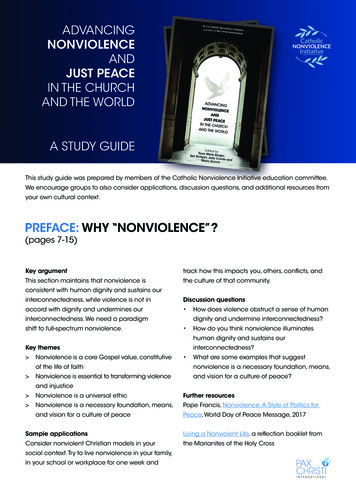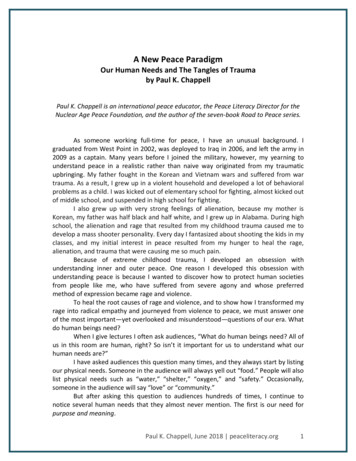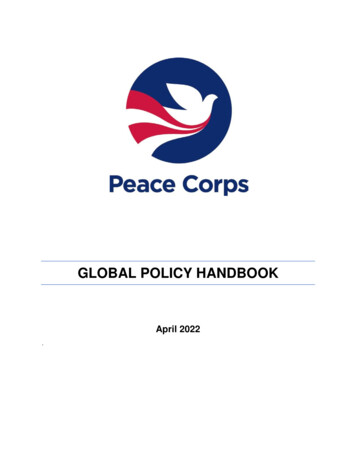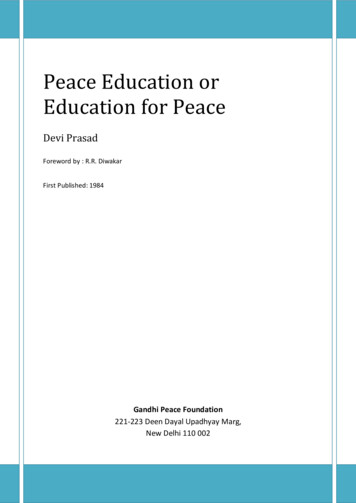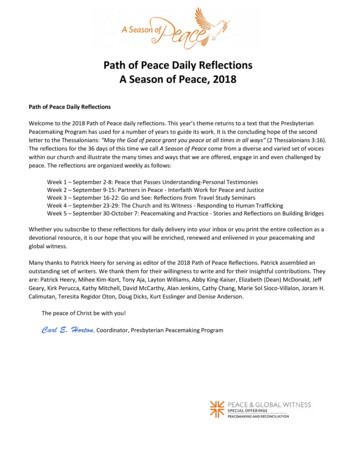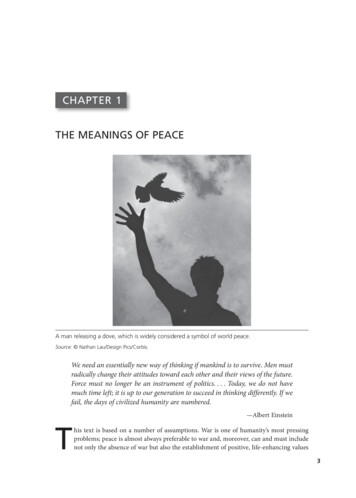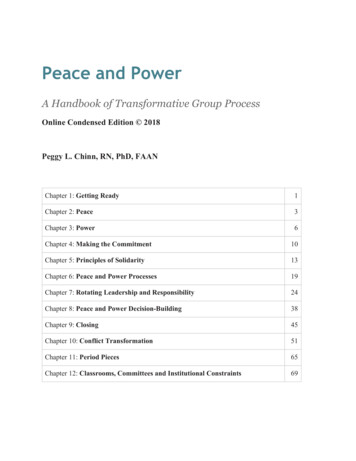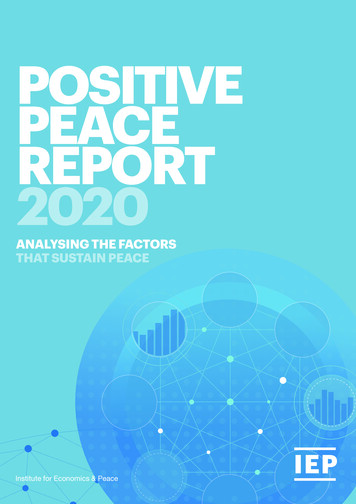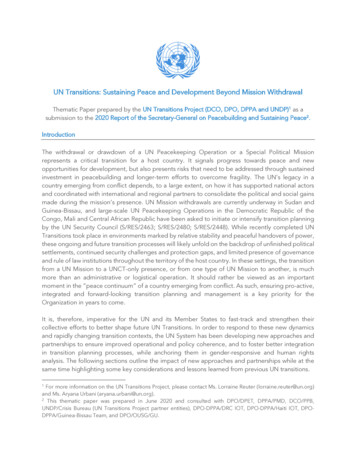
Transcription
UN Transitions: Sustaining Peace and Development Beyond Mission WithdrawalThematic Paper prepared by the UN Transitions Project (DCO, DPO, DPPA and UNDP)1 as asubmission to the 2020 Report of the Secretary-General on Peacebuilding and Sustaining Peace2.IntroductionThe withdrawal or drawdown of a UN Peacekeeping Operation or a Special Political Missionrepresents a critical transition for a host country. It signals progress towards peace and newopportunities for development, but also presents risks that need to be addressed through sustainedinvestment in peacebuilding and longer-term efforts to overcome fragility. The UN’s legacy in acountry emerging from conflict depends, to a large extent, on how it has supported national actorsand coordinated with international and regional partners to consolidate the political and social gainsmade during the mission’s presence. UN Mission withdrawals are currently underway in Sudan andGuinea-Bissau, and large-scale UN Peacekeeping Operations in the Democratic Republic of theCongo, Mali and Central African Republic have been asked to initiate or intensify transition planningby the UN Security Council (S/RES/2463; S/RES/2480; S/RES/2448). While recently completed UNTransitions took place in environments marked by relative stability and peaceful handovers of power,these ongoing and future transition processes will likely unfold on the backdrop of unfinished politicalsettlements, continued security challenges and protection gaps, and limited presence of governanceand rule of law institutions throughout the territory of the host country. In these settings, the transitionfrom a UN Mission to a UNCT-only presence, or from one type of UN Mission to another, is muchmore than an administrative or logistical operation. It should rather be viewed as an importantmoment in the “peace continuum” of a country emerging from conflict. As such, ensuring pro-active,integrated and forward-looking transition planning and management is a key priority for theOrganization in years to come.It is, therefore, imperative for the UN and its Member States to fast-track and strengthen theircollective efforts to better shape future UN Transitions. In order to respond to these new dynamicsand rapidly changing transition contexts, the UN System has been developing new approaches andpartnerships to ensure improved operational and policy coherence, and to foster better integrationin transition planning processes, while anchoring them in gender-responsive and human rightsanalysis. The following sections outline the impact of new approaches and partnerships while at thesame time highlighting some key considerations and lessons learned from previous UN transitions.1For more information on the UN Transitions Project, please contact Ms. Lorraine Reuter (lorraine.reuter@un.org)and Ms. Aryana Urbani (aryana.urbani@un.org).2This thematic paper was prepared in June 2020 and consulted with DPO/DPET, DPPA/PMD, DCO/PPB,UNDP/Crisis Bureau (UN Transitions Project partner entities), DPO-DPPA/DRC IOT, DPO-DPPA/Haiti IOT, DPODPPA/Guinea-Bissau Team, and DPO/OUSG/GU.
The impact of pro-active, integrated and forward-looking UN Transition processes on sustainingpeace Strategic context and policy landscape on UN TransitionsUN Transitions are central to system-wide efforts to prevent conflict, sustain peace, and deliver onthe 2030 Agenda for Sustainable Development. The Secretary-General has made UN Transitions oneof the priorities of his reform agenda in order to ensure a smoother, more coherent and effectivechange of the UN System’s response to evolving needs on the ground. To this end, the recentSecretary-General’s Planning Directive for the development of consistent and coherent UN Transitionprocesses, issued in February 2019, provides enhanced guidance to UN Missions, Country Teamsand HQ entities, particularly on early joint planning and financing, operational support, and staffing.Building on existing policy and guidance on UN integration, in particular the Integrated Assessmentand Planning Policy (2013), the Secretary-General’s Planning Directive on UN Transitions provides aframework to advance both a development and a peace and security approach in the context of UNTransitions, in order to sustain peace and development gains, reduce the risk of relapse into conflict,and help set countries on a path towards achieving sustainable development. The SG’s Directive isbased on insights stemming from previous transition processes which suggest several factors thatdetermine whether a UN transition process will have a positive impact on a country’s peace anddevelopment trajectory. Sustaining political engagement during UN transition processesSustaining political engagement during and after mission withdrawal is essential to support keypeacebuilding priorities. Many of these residual peacebuilding priorities are often highly political innature, yet UN Transitions are often characterized by a decline in the Organisation’s political leverage.This challenge requires the UN to retain adequate capacity for political analysis, as well as for dialogueand convening power with national, regional and international stakeholders, so as to facilitate theimplementation of key reforms and to safeguard enablers of conflict prevention and sustainablepeace. Preserving space for inclusive peacebuilding, even as the Security Council disengages and asthe UN political leverage decreases, requires the design of political strategies that can convene andengage a wide group of stakeholders, including the Security Council, the Peacebuilding Commission,relevant Member States, regional and sub regional organizations, International Financial Institutions(IFIs), and civil society around a shared vision of key priorities and the desired end-state. The criticality of national engagement in transitionsNational engagement is critical in UN transition processes. For transitions to help consolidate andsustain peace efforts as well as the 2030 Agenda for Sustainable Development, their timing,modalities and outcomes must be determined and implemented with national counterparts, includingcivil society networks and women’s organizations and coalitions. To ensure this, transition planningneeds to be closely aligned to national development plans and strategies, while engaging a wideand diverse group of national actors. Meaningful engagement with national and local stakeholdersmust happen at an earlier stage to jointly determine shared priority areas, activities and capacitiesthat need to be supported during and after mission withdrawal. A strong focus must be placed onstrengthening capacities in areas that will be transferred after mission withdrawal, and on setting up
joint planning and coordination structures with national counterparts, including key political and civilsociety actors. Effective financing in transition settingsMission withdrawals often coincide with a lack of adequate focus on financing strategies to supportpredictable and longer-term funding priorities in post-conflict settings. This is compounded by thefact that UN Peacekeeping Operations and Special Political Missions often provide a considerableinjection of economic activity into host countries’ local economies and that their withdrawal, in turn,increases the economic challenges for host countries, particularly in fragile contexts. It is, therefore,important that UN Missions, UNCTs and national authorities take into account economicconsiderations in integrated transition planning processes and elaborate longer-term financingstrategies. This includes tapping into innovative financing modalities that will allow these actors todeliver effectively together and to strengthen partnerships with IFIs and the private sector. In thisregard, the implementation of mandated programmatic activities funded through UN Peacekeeping’sassessed budget represent an innovative tool to facilitate transitions from UN Peacekeeping topeacebuilding. These activities engage strategic partners hailing from UNCTs, NGOs, and nationalcounterparts based on comparative advantages, to ensure continued support in shared priority areas,thus strengthening greater coherence among UN System actors and building critical capacities.Moreover, the Peacebuilding Fund (PBF) has opened a new funding window for transitions, to addressthe “financial cliff” that can appear during transitions. In 2019, 22 per cent of PBF investments werein transition settings, including in Guinea- Bissau, Haiti, Liberia, Sudan, and Côte d’Ivoire, thuscontributing to continuity in addressing peacebuilding and development challenges. Strengthening proactive and integrated transition planningProactive and integrated transition planning is crucial to ensure a timely and forward-looking UNTransition, which requires continuous and targeted support in various areas: from joint analysis andjoint identification of peacebuilding priorities, to the articulation of integrated transition plans andthe strengthening of UN coordination efforts. Since UN transitions involve the reconfiguration of theoverall UN presence and goals, they must be jointly planned, coordinated and managed from theoutset by all UN actors present in the country and at regional and headquarters level, in closepartnership with national, regional and international stakeholders. Greater efforts should be placedon jointly identifying with the UNCT the priority areas and activities, roles, capacities and resourcesto support the Government after Mission withdrawal. Agencies, Funds and Programmes (AFPs) havea crucial role to play and they need to engage proactively and as early as possible in these transitionplanning efforts. To this end, dedicated capacities and human resources, particularly in Offices ofDSRSG-RC-HCs, are critical to support efficient and coherent operational transition planning.
Country case studies: Sudan and HaitiThe UN Transitions in Haiti and Sudan can provide the UN System with key insights to identify andaddress challenges that may arise during future transition processes.Darfur: A whole-of-system UN transitionThe ongoing UN transition in Sudan is a uniquely complex undertaking, given UNAMID’s nonintegrated nature and the Mission’s limited geographical coverage. Moreover, the transition istaking place in the context of difficult political and structural reforms, as well as persistent security,humanitarian and economic challenges. In recognition of these difficult circumstances, the UN andAU’s initial concept for the transition focused on a “whole-of-system” approach. This strategyplaces peacebuilding at its centre and focuses collaboration between the mission and UNCTaround critical peacebuilding priority areas. Central to this collaboration are the State LiaisonFunctions (SLFs), an innovative mechanism for joint-up delivery against these priorities, aiming toenhance UNCT capacities through staff co-location and the transfer of programmatic funds. Theuse of UNAMID’s assessed budget has been critical to the SLF establishment, but it has also raisedfinancial and planning challenges, mainly due to the short and uncertain timeframes of UNAMID’stransition budgets.Recognizing that a more comprehensive approach to the transition was needed, UNAMID and theUN Country Team are implementing a Joint Transition Action Plan covering political, programmaticand security aspects of the transition in Darfur. To strengthen transition coordination,communication and information sharing, a Joint Transition Cell has been established and isfunctional. In addition, a joint Government of Sudan and UN coordination committee has beenestablished to improve State Liaison Functions planning and monitoring of implementation, whilealso addressing challenges as they emerge. Regarding programmatic activities, a total of USD 32.2million was allocated to SLFs from January to December 2019 towards stabilization andpeacebuilding. These programmatic activities are aimed at addressing land and other resourcebased intercommunal conflicts, as well as promoting resilience/durable solutions for returnees,internally displaced people (IDPs) and host communities. Although the planning, execution andmonitoring of SLFs could be strengthened, their interventions are contributing to peacebuildingand social cohesion in communities in four Darfur states.The fluid political and economic environment in Sudan has impacted the UN transition process inDarfur, including the engagement of UNAMID with the UNCT, whose focus is not only on Darfur,but on support to the Sudan-wide political transition. In the remaining months of UNAMID’smandate, the mission and UNCT will need to continue to reinforce joint planning efforts andstrengthen national engagement in the transition process, while also scaling up peacebuildingwork, identifying opportunities for new actors to complement ongoing initiatives, and addressingquestions of long-term sustainability.
Haiti: The transition from MINUJUSTH to BINUHAt its establishment, following the closure of MINUSTAH, the Security Council asked for a twoyear benchmarked exit strategy for MINUJUSTH. It further requested the Mission to work closelywith the UNCT and Government to prepare for its drawdown. The transition from MINUJUSTH toa special political mission, BINUH, working hand-in hand with the UNCT for the implementationof joint priorities, took place as planned in late 2019, although in a challenging political andsocio-economic environment.The UN planning for the transition process was aided by UNHQ through the continuity of the Haitibackstopping team in the merged DPO-DPPA regional operational pillar. The process alsobenefited from close collaboration between DPPA/DPO and DCO, which facilitated theidentification of a common vision to serve as the basis for the follow-on UN presence. A SecretaryGeneral’s directive on Haiti’s transition provided integrated guidance to the UN system. Theplanning also involved dialogue between the SRSG and the Haitian leadership on the use of thePBF, and the process resulted in the eligibility of Haiti for PBF funding. The latter helped bridgethe end of the programmatic funding from the assessed budget of MINUJUSTH and allowed thecontinuation of critical peacebuilding activities by the UNCT. In particular, the Joint Rule of LawProgramme between MINUSTAH/MINUJUSTH and the UNCT, funded largely by the UNPeacekeeping assessed budget, had been designed as a cornerstone of the integrated approachto the continuation of critical activities after the Mission’s closure.The security situation in the country and the absence of a confirmed government during thetransition process meant that the national engagement was not at an optimal level. This resultedin delays in the integrated planning process and impacted the design and implementation of atimely resource mobilization strategy to continue to address joint peacebuilding priorities after theclosure of MINUJUSTH and beyond the PBF allocation.A model of integrated approach: the UN Transitions Project Background and joint structure of the UN Transitions ProjectIn 2014, UNDP, DPO, and DPPA initiated an innovative project to ensure that UN Transitions are wellplanned and managed, to help ensure that the UN is well positioned to provide efficient and effectivesupport to host countries, as they progress towards sustainable development and peace. The UNTransitions Project is widely recognized as a key integrated mechanism providing guidance andsystem-wide support on how to address recurrent challenges related to UN Transitions. Its supporthas resulted in a noticeable organizational shift away from a focus limited to mission withdrawal andtowards a more proactive and forward-looking approach that places emphasis on consolidatingpeacebuilding gains and sustaining peace beyond mission withdrawal. In its current phase (2020 2023), the Project includes the Development Coordination Office (DCO) as a new partner entity andfocuses on institutionalizing lessons learned since the launch of this initiative. By serving the UNsystem as a ‘one-stop-shop’ on transition planning and management, the Project will continue
responding to the increased demand for transition planning support and will centralize capacities andexpertise from across its project partners to provide system-wide integrated assistance. Strengthening policy coherence and guidance on UN TransitionsThe UN Transitions Project has made important achievements to improve organizational practice andknowledge on transition processes in recent years. At the global level, the Project has played acatalytic role in influencing various policy streams with a view to strengthening operational and policycoherence across the development and peace and security pillars, including through support to thereview of the 2013 Policy on Integrated Assessment and Planning (IAP) and the drafting andimplementation of the Secretary-General’s Planning Directive for the development of consistent andcoherent UN Transition processes’ across all mission settings. Furthermore, the Project supported theformulation of reconfiguration options and recommendations put forth in the reports of the SecretaryGeneral to the Security Council on Darfur (S/2019/816) and Guinea-Bissau (S/2018/1086). System-wide support to integrated planning and analysis in transition processesAt the country level, the UN Transitions Project has improved operational coherence in transitioncontexts, by supporting the planning and management of UN Transitions in a number of key prioritycountries, as outlined below:In Haiti, recognizing the need to jointly identify residual peacebuilding priorities and enhancecapacities of the UNCT and national stakeholders to address them during and after MINUJUSTH’swithdrawal, the UN Transitions Project has provided support and accompaniment to the ResidentCoordinator’s Office (RCO) in Haiti on rule of law and peacebuilding programming requirements, andhas put in place planning and coordination modalities for transition planning. The Project has alsoprovided technical expertise during the development of the MINUJUSTH benchmarks and was partof the 2018 Strategic Assessment. In addition, UN priorities and partnerships developed through jointanalysis helped identify Women, Peace and Security (WPS) priorities for BINUH and translate theminto concrete goals for the UNCT.In Darfur, Sudan, the UN Transitions Project has supported UNAMID and the UNCT to pursue awhole-of-UN transition approach. This integrated strategy has prioritized UN collaboration in fourpriority areas and it has helped establish an innovative mechanism for joint-up delivery against thesepriorities, namely the state liaison functions (SLF). Furthermore, the Project has provided surgecapacity on key transition tasks, contributing to the development of the Joint Action Plan for UNTransition in Darfur and deploying a Transition Specialist to the RCO.In support of the transition process in Guinea-Bissau, the UN Transitions Project facilitated a transitionworkshop that enabled UNIOGBIS and UNCT staff to consult and reach agreement on the criticalsteps to be undertaken as part of the transition planning process. Accordingly, agreement wasreached to use the existing UNDAF and the new UNSDCF as the substantive transition plan, whichhelped to strengthen UNCT’s ownership over the process and to articulate a strategy to addresspeacebuilding priorities following UNIOGBIS withdrawal. The Project will also deploy a TransitionSpecialist to contribute to system-wide transition planning efforts.
In Mali, to foster a pro-active, integrated and forward-looking approach to transitions, in line with theSecretary-General’s planning Directive, the UN Transitions Project organized a transition workshopfor MINUSMA and UNCT staff to discuss ways to work more closely in support of key peacebuildingpriorities across the country. The workshop and the subsequent efforts to develop the transitioncalendar have reinforced the implementation of the Integrated Strategic Framework and led to theestablishment of an integrated transition planning mechanism. The steps undertaken in Mali showthat, even in the absence of a mission withdrawal timeline, the SG’s Directive can prompt timelyconversations about UN reconfiguration options, with a view to developing a common vision andapproach to peacebuilding priorities, which builds upon the strength of the different actors.In support of the reconfiguration process of the UN and its priorities in the Democratic Republic ofthe Congo, the UN Transitions Project has deployed a Transition Specialist since 2019 and has alsoprovided surge capacity to support the UNCT and MONUSCO to articulate a Transition concept. Italso participated in the independent Strategic Review Mission in June 2019, which producedrecommendations to adjust the mandate, configuration and responsibilities of MONUSCO with aview to build up UNCT capacities in the country.RecommendationsThe following recommendations outline a response to the aforementioned recurring transitionchallenges that should be addressed by the UN System and Member States in ongoing and upcomingtransition processes: UN Transitions involve UN-wide efforts and require capacities to plan and implement multistakeholder processes, with political, programmatic, financial and operational dimensions, as wellas engagement with a wide range of partners. The UN and Member States need to ensure thatthe necessary capacities and expertise are allocated both at the field and HQ level. In planning post-mission UN configuration, the UN and Member States should address the needsof the country and its people, ensuring that the necessary tools and resources areretained/established to support governments and societies, as they consolidate peace dividendsand move towards sustainable development. Resident Coordinator Offices (RCOs) in post-Mission configurations should be adequatelyresourced in order to maintain political engagement capacities, produce political analysis toidentify and address potential conflict drivers, and support technical assistance programmes. Greater efforts should be placed on jointly identifying with the UNCT the priority areas, activities,capacities and resources needed to support government authorities during and after a UNTransition. UN Security Council decisions on UN transitions should ideally be informed by a wide range ofconsiderations, in order to ensure that peace and security gains are preserved in the longerterm. Towards this end, the advisory role of the Peacebuilding Commission to the Security
Council should be further strengthened, as the PBC can help convey national perspectives, aswell as the views of other important partners. During UN Transitions, meaningful national engagement should be secured through high-leveland early political engagement, along with support from a broad and inclusive range of nationalstakeholders, in order to jointly determine priority areas that need to be supported beyondmission withdrawal. To ensure continued political engagement, partnerships with regional and sub-regionalorganisations should be further strengthened by the UN Security Council through the adoptionof a stronger regional approach to UN Transitions that leverages the political engagementbetween regional stakeholders and national actors. Transition plans should include the engagement of bilateral actors and IFIs, so as to developcoherent approaches aimed at preventing macroeconomic and fiscal shocks and strengtheningnational capacities to consolidate peace. These approaches should also be geared towardsresource mobilization strategies, to facilitate lasting international commitment during and aftera transition.
The impact of pro-active, integrated and forward-looking UN Transition processes on sustaining peace Strategic context and policy landscape on UN Transitions UN Transitions are central to .

